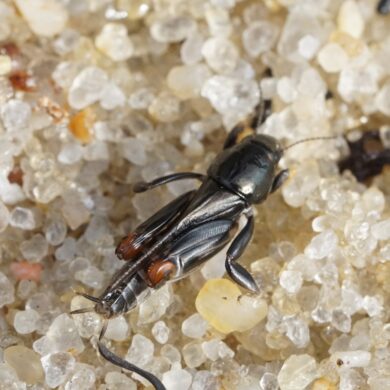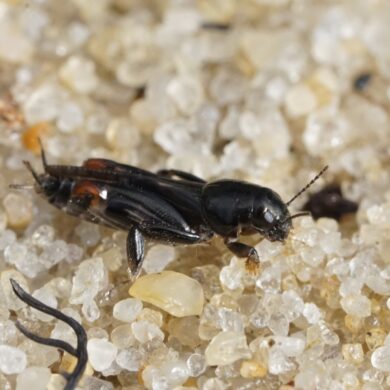
New Orthoptera Species for Martha’s Vineyard
While visiting Long Point Wildlife Refuge on August 29, 2024, I followed an otter slide down to a tiny patch of sandy beach on the shore of Long Cove Pond. Barely noticeable on the damp sand was a small insect, no more than eight or 10 mm long and nearly black in coloration. I crept in close to it and began photographing it, at first not having any sense even of what taxonomic order it belonged to. But the image in my viewfinder showed a compact insect with long, powerful hind legs folded against the body, and I quickly concluded that it was a mole cricket.
Cryptic, even mysterious, mole crickets in general are fossorial and nocturnal, making them very difficult to find and study. It’s possible that no one had ever actually seen a mole cricket on the Vineyard – the only reliable reports I know of came from naturalist Tim Simmons, who remembered hearing the distinctive, quacking call of the northern mole cricket, Neocurtilla hexadactyla, decades ago at Vineyard sites including the shore of Long Cove Pond. Not aware of any other possibilities, I jumped to the erroneous conclusion that I had to be looking at a northern mole cricket.
Things didn’t really add up, though. This insect was far smaller than what I expected for a northern mole cricket (adults of that species range from about 20 to 30 mm in length). Trying to make what I was seeing fit with what I was expecting, I assumed I had found a nymph, or immature. But my insect was also colored very oddly for Neocurtilla, glossy black instead of the dull brown I was expecting. That discrepancy was hard to explain away.

The explanation came quickly when I uploaded some of my photographs as an observation in iNaturalist. The site’s artificial intelligence instantly suggested Neotrydactylus apicialis, a species I couldn’t recall even hearing of and which was certainly not on my radar for finding on the Vineyard. Minutes later, Brandon Woo, a brilliant Orthoptera expert who is very active on iNat, confirmed that identification.
Somebody must know something about this species, which has been reported from across most of the eastern United States as well as in California and Mexico. But very little of that knowledge has made it into places I’ve been able to find. It prefers wet habitat, all sources agree, and feeds on organic matter including algae. But I can’t find any details on the ecology of the strange-looking insect. And I’ve been unable to determine even if it calls, much less what those calls might sound like.
Given its small size and habits, the species may well be overlooked. But in any case it is infrequently encountered in our region: iNaturalist shows just four other observations of Neotridactylus apicialis from Massachusetts, two from the Plymouth area and two northwest of Boston. For reasons that are not clear, only those latter two have made it into the Global Biodiversity Information Facility (GBIF), which normally collects all “research-grade” observations from iNat.
Taxonomically, Neotridactylus is quite distinct from Neocurtilla. Despite their similarity in structure and habits, the two are classified in different suborders, with Neotrydactylus actually more closely related to grasshoppers than to crickets, while Neocurtilla is a true cricket (albeit an odd-looking one). This taxonomic status figures in the most frequently used (if somewhat self-contradictory) common name for Neotridactylus apicialis: Larger Pygmy Mole Grasshopper.
In any event, my mole cricket made a brief, abortive effort at tunneling into the set sand, applying its stubby, hair-tipped forlegs like a pair of trowels. Then it jumped a foot or so into nearby vegetation, where it disappeared. The show was over; I was unable to relocate it. Heaven knows if or when I’ll ever encounter this species again, or if I’ll ever learn more about its habits and ecology.
This is far from the first interesting discovery I’ve made that took root in a misidentification! But the episode is yet another reminder of the remarkable biodiversity of Martha’s Vineyard, and of Long Point Wildlife Refuge in particular. And my experience with Neotridactylus shows the value of platforms like iNaturalist, that make expert knowledge available to anyone, anywhere.
Matt Pelikan is the director of the Martha’s Vineyard Atlas of Life project at BiodiversityWorks. He has been studying the Orthoptera of Martha’s Vineyard since 2010.
